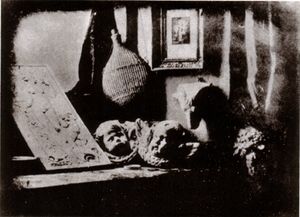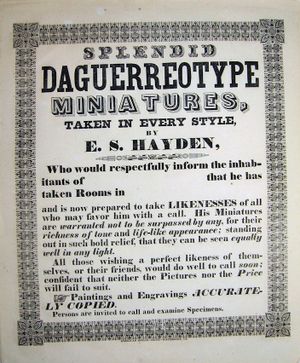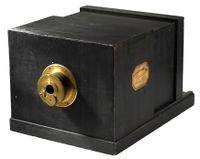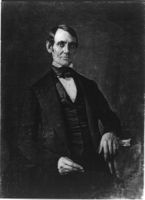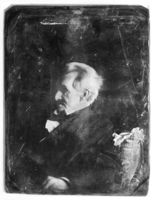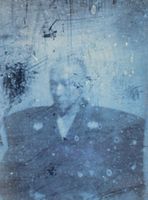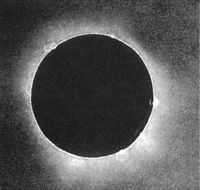داجيرية
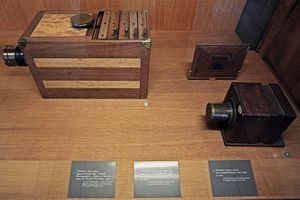
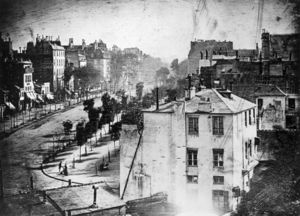
عملية الداگروتيپ The Daguerreotype process، /dəˈɡɛr[invalid input: 'ɵ']taɪp/ (فرنسية: daguerréotype) (وتسمى أيضاً الداگروتيپي)، كانت أول عملية تصوير فوتوغرافي عملي. بإستخدام الكاميرا المظلمة (رسم مساعد للفنانيين وأصبحت تسمى بعد ميلاد التصوير الفوتوغرافي تعرف بالكاميرا الفوتوغرافية) صفيحة ضيقة مضيئة تم تصميمها لحمل صفيحة نحاسية أمامها طبقة رقيقة من الفضة. قبل الإستغناء عن الصفيحة في الكاميرا، كانت الصفيحة تصنع من مادة حساسة للضوء بواسطة أبخرة من البلورات اليودية في صندوق خشبي. بعد الإستغناء عنها، تقوم أبخرة الزئبق بتطوير الصورة ثم تعالج بمحلول ملحي (كلوريد الصوديوم) أو ثيوكبريتات الصوديوم. يجب طلاء الصفيحة بكلوريد الذهب.
المخترع
المخترع، لوي جاك مانديه داگـِر، شارك نيسيفور نيپس الذي توفى بالصدمة (السكة الدماغية)، بعدها حل محله ابنه في الشراكة. بدأ نيپس تجارب على مواد حساسة للضوء وقام بطباعة تلامسية عن رسم، ثم نجح بعدها في تسجيل أول صورة بالكاميرا المظلمة باستخدام مواد حساسة للضوء - أول صورة فوتوغرافية في العالم.
كان الهدف الأصلي لنيپس هو إيجاد طريقة لنسخ المطبوعات والرسومات لأغراض الطباعة الحجرية.
كان داگر يدرك صعوبة جمع patent royalties from the invention, and there had been an unsuccessful attempt by Niépce and Daguerre to issue stock so as to profit from the invention of the daguerreotype. The president of the French Academy of Science, the astronomer François Arago who sat as a Deputy in the French House of Deputies became enthusiastic about the invention and a committee was formed whereby Arago would present a bill in the House of Deputies and Gay-Lussac a similar bill in the Upper house of the French Parliament. حصل داگر وابن نيپس على معاش مدى الحياة، وستتبرع الحكومة الفرنسية بالاختراع للعالم.
الكاميرا المظلمة
نسخ الداگروتيپ وإعادة الإنتاج بواسطة الطباعة الحجرية
التبشير في عصر الاستنساخ الآلي
الداگروتيپ كتطبيق فلكي في عقد 1879
التصوير الإنساني
تقليل فترة العرض
الاختراع
التزايد
الداگروتيپات المعاضرة
انظر أيضاً
Joseph-Philibert Girault de Prangey
معرض الصور
Daguerreotype camera built by La Maison Susse Frères in 1839, with a lens by Charles Chevalier
The first authenticated image of Abraham Lincoln was this daguerreotype of him as U.S. Congressman-elect in 1846, attributed to Nicholas H. Shepard of Springfield, Illinois
Daguerreotype of Andrew Jackson at age 77 or 78 (1844 or 1845).
Ichiki Shirō's 1857 daguerreotype of Shimazu Nariakira, the earliest surviving Japanese photograph
The solar eclipse of July 28, 1851 is the first correctly exposed photograph of a solar eclipse, using the daguerreotype process.

الهوامش
- ^ Carlisle, Rodney P. Scientific American Inventions and Discoveries: All the Milestones in Ingenuity—From the Discovery of Fire to the Invention of the Microwave Oven. New Jersey: John Wiley & Sons, Inc., 2004. ISBN 0-471-24410-4
قراءات إضافية
- Newhall, Beaumont The Daguerreotype in America ISBN 0486233227 ISBN 978-0486233222 Dover Publications.
- Gernsheim, Helmut, and Alison Gernsheim. L.J.M. Daguerre: the history of the diorama and the daguerreotype. New York: Dover Publications, 1968. ISBN 0-486-22290-X
- Barger, Susan M and White, William B. The Daguerreotype: Nineteenth-Century Technology and Modern Science Washington, D.C.: Smithsonian Institution Press, 1991
- Rudisill, Richard. Mirror image: the influence of the daguerreotype on American society. Albuquerque: University of New Mexico Press, 1971.
- Coe, Brian. The birth of photography: the story of the formative years, 1800–1900. London: Ash & Grant, 1976. ISBN 0-904069-06-0.
- Sobieszek, Robert A., Odette M. Appel-Heyne, and Charles R Moore. The spirit of fact: the daguerreotypes of Southworth & Hawes, 1843–1862. Boston: D.R. Godine, 1976. ISBN 0-87923-179-3
- Pfister, Harold Francis. Facing the light: historic American portrait daguerreotypes: an exhibition at the National Portrait Gallery, September 22, 1978–January 15, 1979. Washington, D.C.: Published for the National Portrait Gallery by the Smithsonian Institution Press, 1978.
- Richter, Stefan. The art of the daguerreotype. London: Viking, 1989. ISBN 0-670-82688-X.
- Barger, M Susan, and William B White. The daguerreotype: nineteenth-century technology and modern science. Washington: Smithsonian Institution Press, 1991. ISBN 0-87474-348-6
- Wood, John. America and the daguerreotype. Iowa City: University of Iowa Press, 1991. ISBN 0-87745-334-9.
- Wood, John. The scenic daguerreotype: Romanticism and early photography. Iowa City: University of Iowa Press, 1995. ISBN 0-87745-511-2.
- Lowry, Bates, and Isabel Lowry. The silver canvas: daguerreotype masterpieces from the J. Paul Getty Museum. Los Angeles: The Museum, 1998. ISBN 0-89236-368-1.
- Davis, Keith F., Jane Lee Aspinwall, and Marc F. Wilson. The origins of American photography: from daguerreotype to dry-plate, 1839–1885. Kansas City, MO: Hall Family Foundation, 2007. ISBN 978-0-300-12286-2.
- Kenney, Adele. Photographic Cases Victorian Design Sources 1840–1870, 2001 ISBN 0-7643-1267-7.
- Hannavy, John. Case Histories: The Presentation of the Victorian Photographic Portrait 1840–1875, 2005. ISBN 1-85149-481-2.
وصلات خارجية
- Historique et description des procédés du daguerréotype rédigés par Daguérre, ornés du portrait de l'auteur, et augmentés de notes et d'observations par MM Lerebours et Susse Frères, Lerebours, Opticien de L'Observatoire; Susse Frères, Éditeurs. Paris 1839 (French)]
- R. Derek WOOD, A State Pension for L. J. M. Daguerre for the secret of his daguerreotype technique Published in the quarterly journal Annals of Science September 1997 (Vol 54, No.5, pp. 489-506)
- WATCH: George Eastman House "The Daguerreotype – Photographic Processes
- The J. Paul Getty Museum Early Photography: Making Daguerreotypes video
- Musée Orsay Daguerreotype Collection - under heading Overview click on Index of Works and search DAGUERREOTYPE
- Hill, Levi L. A Treatise on the Daguerreotype. The Whole Art Made Easy. 1850
- The Daguerreotype Process. Sussex PhotoHistory.
- Daguerre (1787–1851) and the Invention of Photography. Malcom Daniel, Department of Photographs, The Metropolitain Museum of Art
- The Daguerreian Age in France 1839 - 1855. Malcom David. Department of Photographs, The Metropolitan Museum of Art
- *Xiaoqing Tang, Paul A. Ardis, Ross Messing, Christopher M. Brown, Randal C. Nelson, Patrick Ravines, and Ralph Wiegandt. University of Rochester, Rochester Digital analysis and restoration of daguerreotypes University of Rochester
- The Nanotechnology of the Daguerreotype University of Rochester
- Cincinnati Waterfront Panorama Daguerreotype University of Rochester
- International Contemporary Daguerreotypes community (non profit org)
- The Daguerreian Society: History, and predominantly US oriented database & galleries
- The Daguerreotype: an Archive of Source Texts, Graphics, and Ephemera
- Daguerreotype Portraits and Views, 1836-1864: US Library of Congress
- The American Handbook of the Daguerreotype from Project Gutenberg
- The Social Construction of the American Daguerreotype Portrait
- 19th Century New Orleans Photography
- Photography, Old & New Again by John Fleischman and Robert Kunzig from Discover Magazine Article on Daguerreotypes and Holograms
- A University of Utah Podcast on Daguerreotype Theories
- Daguerreotype Plate Sizes
- Library of Congress Collection
- Photos The Boston Public Library's Cased Photo Collection on Flickr.com
- Daguerreotype collection at the Canadian Centre for Architecture
- First mention of the use of bromine in daguerreotypy
- The first photograph
